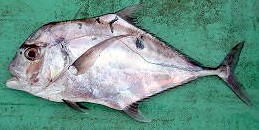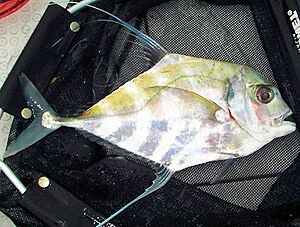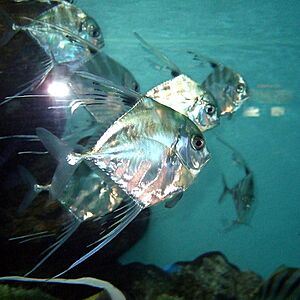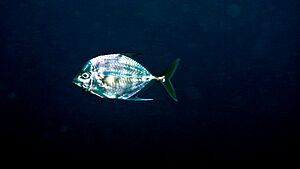African pompano facts for kids
Quick facts for kids African pompano |
|
|---|---|
 |
|
| Conservation status | |
| Scientific classification | |
 |
|
| Approximate distribution of the African pompano throughout the tropical oceans. Note that only juveniles are pelagic, with adults inhabiting coastal areas. | |
| Synonyms | |
|
The African pompano (Alectis ciliaris) is a cool fish found in warm, tropical waters all over the world. People also call it the pennant-fish or threadfin trevally. It belongs to the jack family, called Carangidae.
Adult African pompanos usually live near coastlines. Young ones, called juveniles, often float with ocean currents in the open ocean. They are similar to other fish in their group, Alectis. A key way to tell them apart is the curved shape of their head near their eyes. Young African pompanos have long, thin tips on their dorsal and anal fins. These long threads might help scare away predators.
This fish lives in waters less than 100 meters deep. It eats different kinds of crustaceans and small fish. The African pompano is not a huge part of the fishing industry. But people do catch them with hooks and lines. Young ones are sometimes caught in nets near beaches. Many people also enjoy catching African pompanos for sport. They are known to be very strong fighters, especially the bigger ones!
Contents
What is an African Pompano?
The African pompano, Alectis ciliaris, is one of three types of fish in the Alectis group. This group is part of the larger jack and horse mackerel family called Carangidae. The Carangidae family has 33 different groups of fish. All these fish belong to the order called Carangiformes.
The scientific name Alectis ciliaris was first given by a German scientist named Marcus Elieser Bloch in 1787. Even though it's called a "pompano," it's not a "true pompano" like the fish in the Trachinotus group. It's more closely related to fish known as jacks and trevallies. Its common names, like "threadfin trevally," come from the long, thin fins of the young fish.
How to Identify an African Pompano
Like many fish in the jack family, the African pompano has a body that is tall and flat from side to side. Imagine squeezing a fish between two plates; that's "laterally compressed." The deepest part of its body is in the middle. Its head and tail get narrower. Both the top and bottom parts of its body are curved. A main way to tell an adult African pompano apart is its more curved head. Another fish, Alectis indicus, has a more angled head.
This fish has a few hard spines in its first dorsal fin. Then it has one spine and 18 to 20 soft rays in its second dorsal fin. The anal fin has two spines and 15 or 16 soft rays. Its pectoral fins are long and curved. The skin looks smooth, but it has tiny scales hidden in it.
Young African pompanos look special because of their long, thread-like fins. These "threadfins" get shorter as the fish grows up. As they mature, they also become longer and look more like other types of jacks.
The body of the fish is a shiny, metallic blue or blue-green on top. It's darkest on the head and upper body. The underside is more silvery. Young fish have five dark, V-shaped stripes on their bodies. They also have a black spot near the base of some of their dorsal fin rays. The base of the long fin threads is dark blue or black. All other fins are light or clear.
African pompanos can grow to be about 130 centimeters (about 4.2 feet) long. Some have been reported to be even longer, up to 150 cm (almost 5 feet). The heaviest one ever officially recorded weighed 22.9 kilograms (about 50.5 pounds).
Where African Pompanos Live
African pompanos live in warm, tropical oceans and seas around the world. They prefer water temperatures between 18 and 27 degrees Celsius (65 to 80 degrees Fahrenheit). You can find them near the coasts of North and South America, Africa, and all over the Indian Ocean. They are also found along the coasts of Asia and Australia, and around many Pacific islands.
Adult African pompanos like coastal waters up to 100 meters deep. They often hang out around reefs and wrecks. Young fish live in both coastal areas and the open ocean. Since they rely on ocean currents, young African pompanos have sometimes been found in estuarine waters (where rivers meet the sea) in southern Australia. However, they usually don't survive the cold winters there.
In one interesting case, many more African pompanos appeared off North Carolina after a hurricane had passed through.
What African Pompanos Eat and How They Live
African pompanos are predatory fish that often swim in groups. They mostly eat different kinds of crustaceans, like crabs, shrimp, and tiny copepods. They also eat cephalopods (like squid) and small fish.
Bigger fish, such as mackerel and tunas, and sharks, hunt African pompanos. The long, thread-like fins of young African pompanos look a bit like jellyfish. This mimicry might help protect them from predators.
Scientists don't know much about how they reproduce or how long it takes them to grow up. However, a study in India found that there were many young African pompano larvae in April. The study also described their eggs and larvae in detail. It's thought that in Mexico, they lay their eggs over sandy areas in the spring.
African Pompanos and People


African pompanos are popular with both recreational (sport) and commercial fishermen. This is because they can grow quite large and are considered good to eat. However, some people say their meat quality varies. It's important to know that larger African pompanos have been linked to a type of food poisoning called ciguatera. So, it's probably best not to eat very large ones.
Young African pompanos are attractive, so some people try to keep them in aquariums. But they usually don't live very long in captivity.
Adult African pompanos are often caught by trolling (dragging a line behind a boat) or other hook-and-line methods. However, they usually don't make up a large part of the total fish caught. Young fish are sometimes caught using large nets called beach seines. The fish are sold fresh, or sometimes dried and salted.
Anglers love catching African pompanos because they fight hard. Places like Florida, Thailand, and many islands in the Pacific and Indian Oceans have popular sport fisheries for them. For bigger fish, anglers use strong fishing gear. This helps stop the fish from hiding in underwater structures like reefs or wrecks when they try to escape. Smaller fish can be caught with lighter gear, but it takes skill to land them.
African pompanos can be caught using both bait and lures. Small live fish or large prawns are good choices for bait. Lures like jigs or streamers work well when fished on deep reefs and wrecks. They have also been known to bite trolled lures. Sometimes, they even go after saltwater flies or poppers on the surface.
The IGFA (International Game Fish Association) keeps records for African pompanos caught in the United States. The biggest one ever caught with a rod and reel weighed 22.90 kg (50.5 pounds). This record fish was caught off Daytona Beach, Florida in 1990. In Florida, there's a rule that African pompanos must be at least 24 inches long to keep. Also, you can only keep two fish per boat per day.
Images for kids
See Also
- List of marine aquarium fish species





